Post-Fertilisation Structures and Events | Biology Class 12 - NEET PDF Download
What are Post Fertilisation Events ?
Post-fertilization events in plants refer to the series of processes that occur after successful pollination and fertilization. These events are important for the development of seeds and, ultimately, the production of new plants.
Let's break down the post-fertilization events in more detail:
Development of Endosperm
After double fertilization in plants, a primary endosperm cell forms, containing the primary endosperm nucleus (PEN). Typically, the PEN undergoes multiple rounds of nuclear divisions, resulting in the creation of free-nuclear endosperm tissue. Later on, cell walls develop around these free nuclei, giving rise to cellular endosperm. This cellular endosperm tissue surrounds the developing embryo and serves as a source of nourishment.
The endosperm is a type of tissue, which is present in the seeds of flowering plants during the time of seed development. Reserve food materials are present in the cells of endosperm tissue. It provides nutrition to the developing embryo in the form of starch.
Endosperm development is classified into three types. These are as follows:
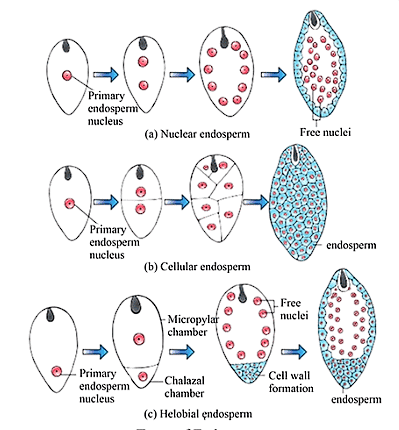
Types of Endosperm on the basis of Development
(i) Nuclear endosperm formation: In this process, the primary nucleus of the endosperm undergoes a nuclear division repeatedly to produce free nuclei without wall formation.
(ii) Cellular endosperm formation: During nuclear division, the formation of the cell occurs and it leads to cellular endosperm formation. Cellular endosperm is seen in coconut meat.
(iii) Helobial endosperm formation: It is an intermediate type of endosperm formation between cellular and nuclear type endosperm formation.
During seed maturation or in the mature seed, the developing embryo may either utilize the endosperm completely or it is used by the seed during seed germination
Peas and beans are examples of plant species in which the embryo consumes the endosperm during its growth. On the other hand, in species like castor beans, wheat, maize, and barley, the endosperm remains preserved within the mature seed.
Development of Embyro
The embryo is another structure that results from double fertilization in plants. Embryogeny, the process of embryo development, typically starts when a sufficient amount of endosperm is present to provide nourishment.
Monocots and dicots are two major categories of flowering plants. They are differentiated based on the number of cotyledons (seed leaves) in their embryos. Monocots have one cotyledon, while dicots have two cotyledons.
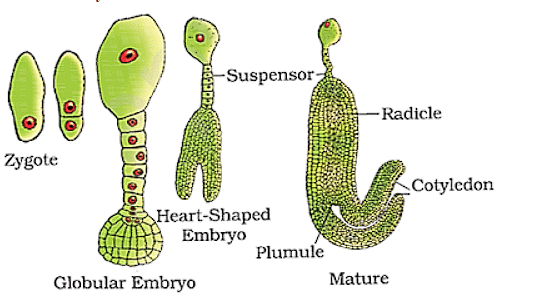 Stages of Embryo Development in Dicots
Stages of Embryo Development in Dicots
Difference b/w Embryo and Endosperm
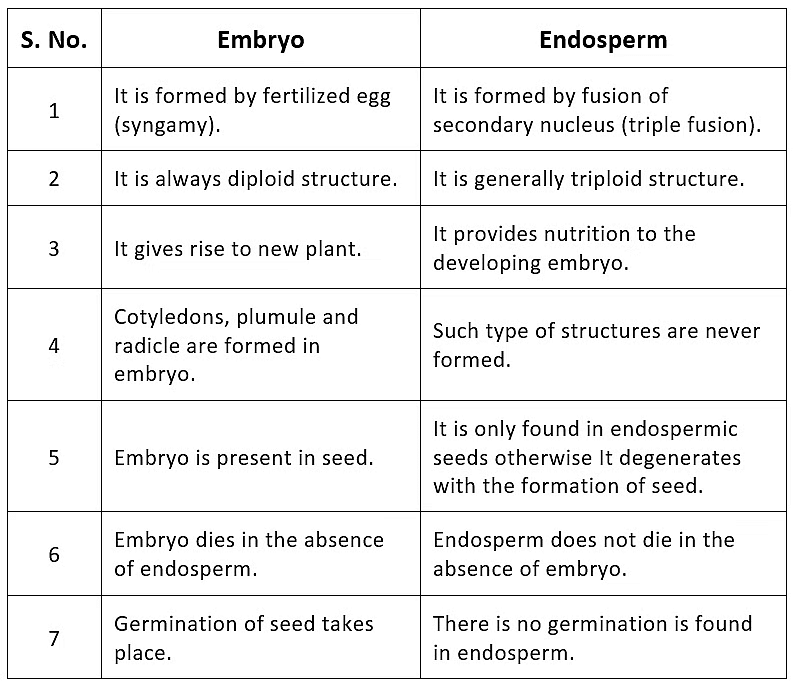
Development of Seeds
- The whole plant exists in a seed. The plant is the main base of the whole living world. So it can be said that the seed is the most important structure.
- In angiosperm, after the fertilization, the egg cell changed into an embryo, ovary changed into fruit and ovule change into seed.
- Morphologically, the ripened ovule is known as the seed. In other words, seed is a mature, integumented megasporangium.
- Seeds are characteristic of Spermatophytes (Gymnosperms and Angiosperms).
 Structure of Seed
Structure of Seed A typical mature seed is having three main parts:
1: Seed Coat
- The outer, protective covering of the seed is called the seed coat, which develops from integuments of the ovule. In seeds developing from bitegmic ovules, there are two distinct layers in the seed coat.
- The outer layer is thick, hard and leathery (developing from outer integument), called testa, whereas the inner layer is thin and papery or membranous (developing from inner integument), called tegmen.
- In seeds developing from unitegmic ovules, there is a single-layered seed coat. The seed coat performs the usual protective function.
- The seed is attached to the fruit wall or pericarp by means of a stalk called funicle or funiculus. The point of attachment of funiculus to the body of the mature seed is called hilum.
- A small opening or pore called micropyle is present just near the hilum, which is the way of entry of water into the seed. As most of the ovules in angiosperms are inverted or anatropous, so a ridge called raphe is present.
2: Embryo
- The embryo is the most important part of the seed, which represents a minor tiny future plant. Embryo develops from fertilized egg (zygote).
- The embryo is having an embryonal axis or main axis called tigellum, to which one or two cotyledons (seed leaves) are attached, depending upon whether the seed is monocot or dicot.
- The portion of the embryonal axis or tigellum below the point of attachment of cotyledons is called hypocotyl, which bears a radicle or future root at its tip.
- Similarly, a portion of the embryonal axis or tigellum above the point of attachment of cotyledons is called epicotyl, which bears plumule (future shoot) at its tip.
3: Endosperm
- It is the nutritive tissue that may be present or absent in the seeds.
- The angiospermic seed is classified into two categories on the basis of presence or absence of endosperm in seeds:
- Non-Endospermic or Ex-Albuminous Seed
- Endospermic or Albuminous Seed
(i) Non-Endospermic or Ex-Albuminous Seed: Such type of seeds do not have an endosperm at maturity, therefore are called non-endospermic or exalbuminous seeds. The endospermic tissues are absorbed during the development of the embryo. The absorbed food materials from the endosperm are stored in cotyledons, that why they become so large and fleshy.
Example: Capsella and most of the dicotyledons. But Castor seed is endospermic.
Non-endospermic dicot seeds: Gram, Bean, Pea, cucumber, Tamarind.
Non-endospermic monocot seeds: Pothos (money plant), Vallisneria, Alisma, Amorphophallus.
(ii) Endospermic or Albuminous seed: This type of seeds, food is stored in endosperm. Such seeds are called endospermic seed or Albuminous seed. The endospermic tissue in these seeds utilize during the germination of seed and their cotyledons are thin and membranous.
Example: Most Monocot seeds like Wheat, Rice, and Maize etc.
Endospermic dicot seeds: Castor, Papaya, Cotton.
Endospermic monocot seeds: Maize, Rice, Wheat and Coconut.
Note:
Sometimes, some part of the nucleus remains unused which is present in the form of a thin layer around the endosperm is called perisperm.
Example: Betelnut, Black pepper, Castor.
Monocotyledonous and Dicotyledonous Seed
- In Monocotembryo, there is a single cotyledon called scutellum.
Example: Grasses like Wheat. - On the opposite side of the scutellum is a tongue-shaped outgrowth remains of the second cotyledon is present called epiblast.
- In Dicot albuminous seed-castor (Ricinus communis), there is a specific outgrowth called caruncle or strophiole, present over micropyle. It is formed by the proliferation of cells of the outer integument at the tip. The caruncle is somewhat spongy and helps in the absorption of water during the germination of seed.
- On the basis of cotyledon in the seed of angiosperm are called Monocotyledon (one cotyledon) and Dicotyledons (two cotyledons).
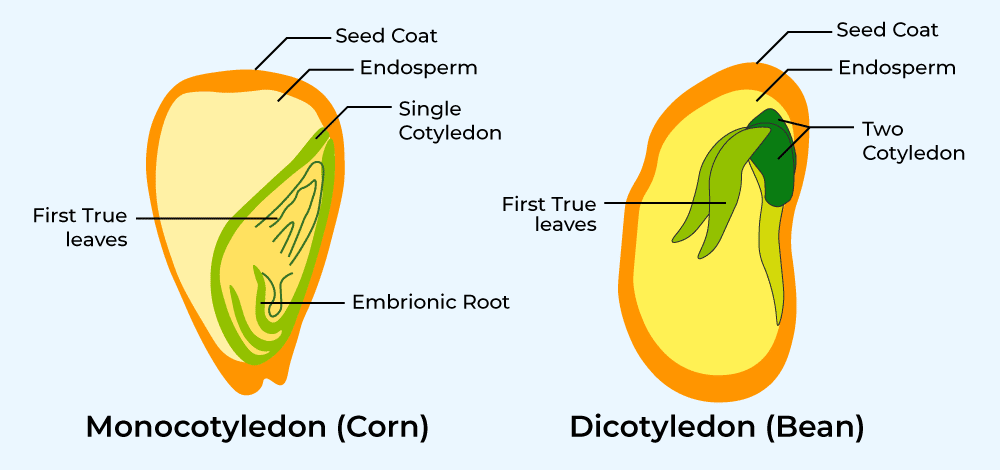
Table: Difference between Monocotyledonous and Dicotyledonous Seed

(i) Structure of Bean Seed (Dicotyledonous Seed)
- Bean seed is kidney-shaped having a concave side and a convex side.
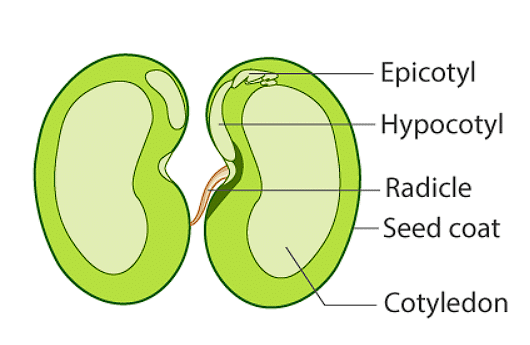 Bean Seed
Bean Seed - The concave side is slightly darker and posses a white elongated scar is called the hilum, which marks the point of attachment of the seed with the funiculus.
- A small pore lies adjacent to the hilum, called micropyle, which performs the function of absorbing water during germination.
- There is a short ridge on the other side of the hilum. It is called the raphe.
- The Bean seed has two seed coats. The outer seed coat is called testa. It is hard, thick, smooth and in various colours. It develops from the outer integument of the ovule.
- The inner coat is white, membranous and thin. It is called the tegmen. It is difficult to separate tegmen from testa. The seed coats can easily be removed if the seeds are soaked in water for a few hours. Each seed encloses an embryo which can be examined after removing the seed coats.
- The bulk of the embryo consists of two large, white and kidney-shaped cotyledons (or seed leaves). They store reserve food material in the form of carbohydrates and proteins to provide nourishment to the embryo at the time of seed germination and growth of the young seedling.
- The cotyledons are attached laterally to the curved embryonal axis at the cotyledonary node. The micropylar end of the embryonal axis is rod-shaped and slightly bulged. It is called radicle (or the embryonic root). The other side of the embryonal axis lies in between the two cotyledons. It is called plumule (or the shoot-tip).
- The shoot tip remains protected by two small, folded leaves. The portion of the embryo axis between the plumule and cotyledonary node is called epicotyl. The portion of the axis between the radicle and cotyledonary node is called the hypocotyl.
(ii) Structure of Maize Grain (Monocotyledonous Seed)
- A grain of maize (Zea mays) is in fact a dry one-seeded indehiscent fruit of caryopsis type in which pericarp (of fruit wall) is fused with the seed coat. The covering of grain encloses two major parts, an endosperm and an embryo. As seen in the longitudinal section, the major portion of grain is occupied by a large starchy endosperm.
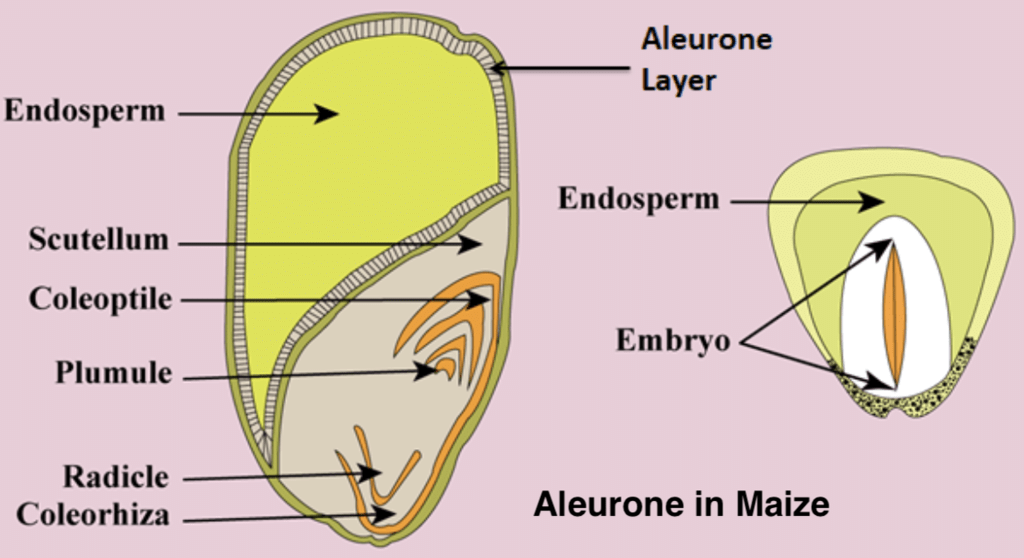
- It is surrounded by a special one-celled thick layer, called the aleurone layer. The cells of the aleurone layer are filled with proteinous grains which play an important role at the time of germination.
- The embryo consists of an upper shield-shaped scutellum which is actually a cotyledon. The scutellum is closely pressed against the endosperm and helps in the translocation of nutrients from endosperm to the growing embryo at the time of germination and seed growth.
- The epidermal tissue of the scutellum lying in direct contact with the endosperm is both secretory and absorptive in function. It secretes certain hormones into the endosperm which synthesize enzymes.
- These enzymes are responsible for the decomposition of stored nutrients and convert them into a soluble state. The soluble nutrients are then absorbed by the epithelial layer of scutellum and transferred to the growing embryo.
- The scutellum is attached laterally to the embryonal axis. One end of the embryonal axis points towards the pointed end of the grain. It is called the radicle. The radicle is covered by a protective sheath called coleorhiza.
- The other end of the embryonal axis, which faces towards the broader end of the grain, is called plumule. The plumule is surrounded by a conical protective sheath, called coleoptile. The coleoptile is capable of growth and covers the growing shoot tip till it passes through the soil during germination.
Germination of Seed
The process by which the dormant embryo wakes up (becomes active) and begins to grow is known as germination of seed. The embryo of the seed grows into a sporophyte plant. The radicle produces the primary root. The plumule develops short and later on cotyledons degenerates.
Dormancy of Seed
- The presence of dormancy in a seed is the most important characteristic feature of plants. Because of this character, seeds remain viable for many years.
- The seeds are dispersed very far places through water, air or insects. Most of the seeds are unable to germinate just after dispersal. They germinate after some time.
- The time between the maturation and germination of the seed is known as the "Dormancy period". The state of inhibited germination as a result of internal causes is usually called 'dormancy'.
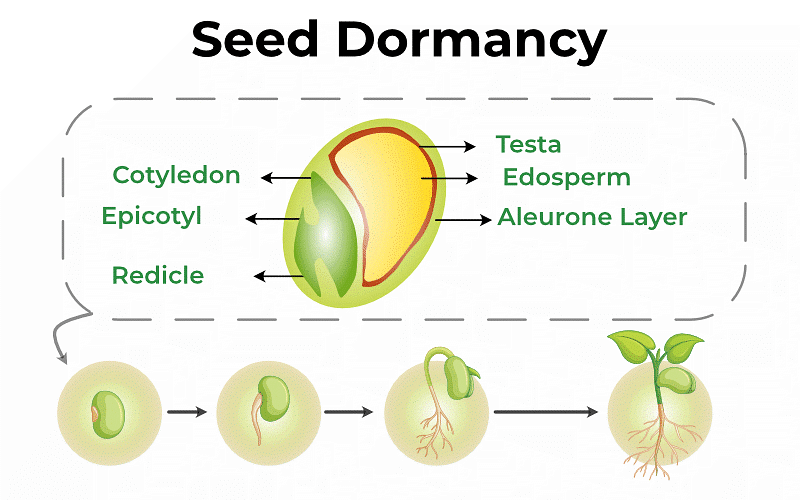
- This seed dormancy is of considerable advantage to the plant which helps to pass on adverse environmental conditions. The embryo remains inactive in this period and all the growth processes suspended temporarily.
Development of Fruit
The process involves the transformation of ovules into seeds, ovary into fruit, and the development of pericarp. Fruits can be classified based on their characteristics and may involve various dispersal mechanisms. Additionally, some fruits develop with contributions from parts other than the ovary, leading to the classification of true fruits and false fruits.
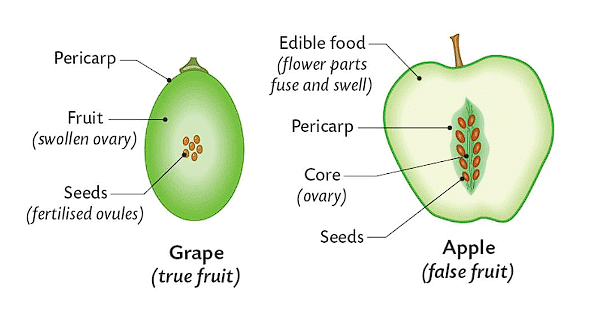 Types of Fruit
Types of Fruit
Parthenocarpy is a unique phenomenon where fruits develop without fertilization, and it can be induced artificially to produce seedless fruits.
Types of Fruit
(i) True Fruits: These develop solely from the ovary of the flower, like grapes and figs.
(ii) False Fruits: In examples like apples and strawberries, other parts of the flower contribute to fruit formation.
(iii) Parthenocarpy: A cool term for fruits developing without fertilization, like bananas.
Apomixis
- The term ‘Apomixis’ was introduced by Winkler(1908). ‘Apomixis is the substitution of sexual reproduction, which does not involve meiosis and syngamy.’
- Apoximis refers to the formation of the plant from a seed without fertilization or normal sexual reproduction. This mechanism produces clones, hence can be considered as a form of asexual reproduction.
It is of two types:
(i) Vegetative Reproduction: It is a type of asexual reproduction, mostly in plants when a plant part is detached and produces new progeny.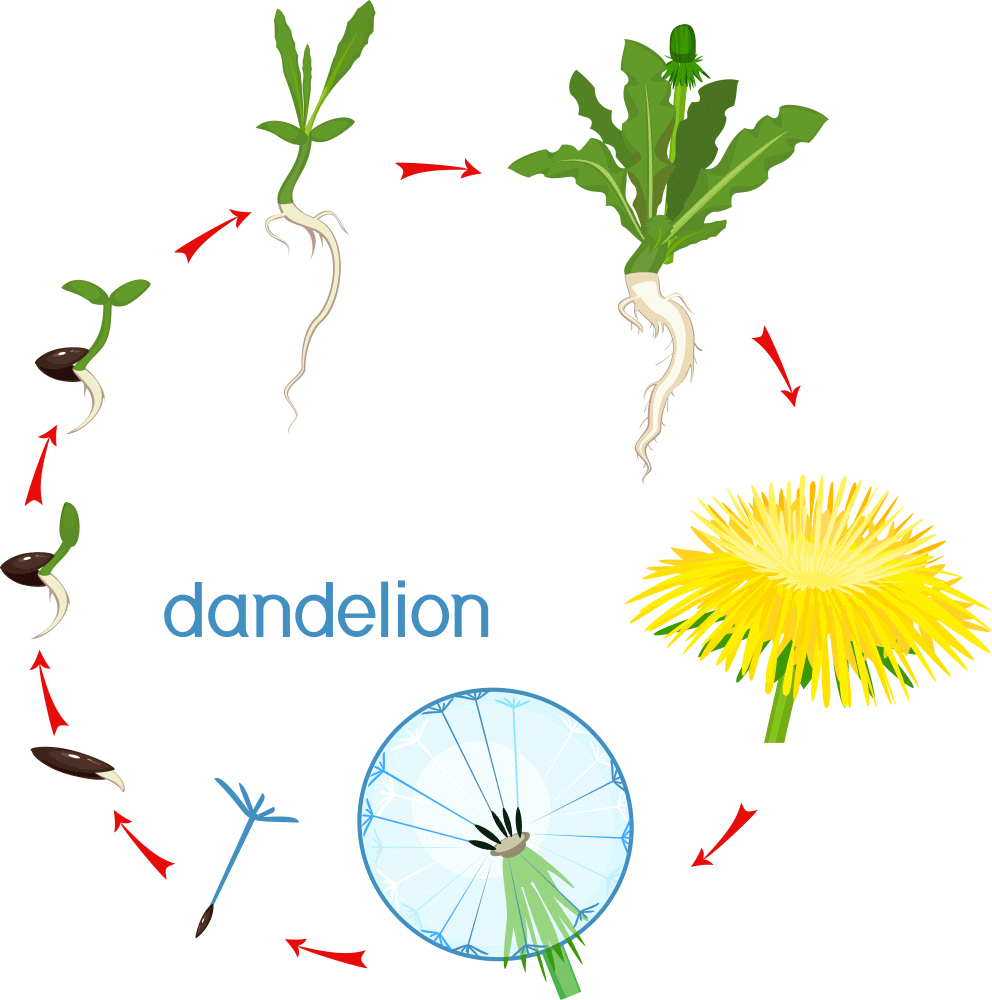 Apomixis: Vegetative Propagation
Apomixis: Vegetative Propagation
(ii) Agamospermy: Process which involves sex cells but takes place without fertilisation or meiosis.
(a) 
(b) Adventitive Embryony: The nucellar or integumentary cells produce a diploid embryo.
(c) Apospory: Cell, outside the embryo sac produces aposporic embryo sac.
Polyembryony
Polyembryony is essentially a reproductive strategy where multiple embryos develop from a single fertilized egg. This process results in offspring that are genetically identical to each other but different from their parents. In the case of humans, this is what gives us identical twins.
Old NCERT Syllabus
➢ Special Points
- After the observation of the first two divisions of the primary endosperm nucleus, endosperm can be identified whether it would be nuclear or cellular endosperm.
- The endosperm is absent in some Angiosperms.
Example: Orchidaceae, Podostemaceae and Trapaceae. - Exceptionally, some of the plants have diploid endosperm instead of triploid such as in Oenothera.
- Maize and Tomato have mosaic endosperm in which patches of different colours are present.
- The endosperm in Betalnut is rough-surfaced. It is known as "ruminate endosperm".
The drinking portion is nuclear endosperm and the edible portion is cellular endosperm in Coconut.
➢ Development Of Embryo In Dicot
- The development of embryos in Capsella is first time discovered by "Hanstein".
In Angiosperm, Zygote undergoes a resting phase. - When the endosperm is formed, the development of the zygote starts. In the beginning, it absorbs food from the endosperm and increases in size then after a layer secreted by itself. Now it is called Oospore.
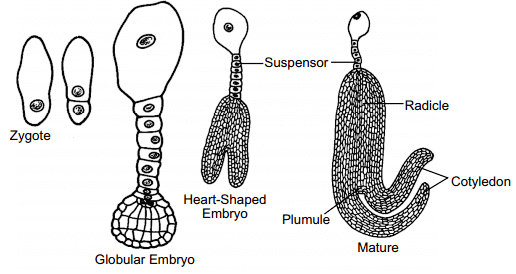 Development of Dicot Embryo
Development of Dicot Embryo - The first division of Oospore is transverse, resulting in two cells are formed.
- The one cell that lies towards the micropyle is called basal cell or suspensor cell.
- The other cell is formed towards the Chalaza is called apical cell or terminal cell or embryonal cell.
- The basal cell and embryonal cell divide simultaneously.
- The basal cell divides transversely and the apical cell divides vertically resulting, in two suspensor cells and two embryonal cells formed. This stage is made up of four cells which are arranged in a 'T' shaped structure. Embryonal cells divide vertically to form four Embryonal cells. This is the quadrant stage of the embryo.
- The two suspensor cells divided by transverse divisions forming a 6-10 celled long filament like structure is termed suspensor. The main function of the suspensor is to push the developing embryo into a food-laden endosperm to provide nutrition.
- The micropylar cell of the suspensor swells up. This cell of suspensor is known as haustorial-cell.
- The cell of the suspensor lying near the embryonal cells is called hypophysis. This cell combines with radicle to form the apex of the root (Root cap).
- These four cells quadrant embryos further divide transversely to produce eight. The eight celled stage of the embryo is called the octant stage. The eight cells of octant are arranged in two tiers.
- The four cells of the octant embryo lying near the hypophysis are known as hypobasal cells and four cells present towards the chalaza termed as epibasal cells.
- The hypobasal cells give rise to radicle and hypocotyl and epibasal cells give rise to two cotyledons and plumule of the embryo.
- All the cells of octant divided by periclinal division so that a 16 celled globular embryo is formed (Proembryo).
- Due to the fast division of embryonal cells of the globular embryo, a heart-shaped embryo is formed. All the cells of this embryo are meristematic.
- Due to the fast growth in two lobes of the heart-shaped embryo, they develop into two cotyledons. Both the growing cotyledons turn in downwards due to the curved position of the body of the ovule of Capsella.
- The tissues are present above the joining place of both the cotyledons are responsible to form plumule and behind it, epicotyl is formed.
- The tissues present opposite to the plumule give rise to radicle.
- This curved position of the embryo is called the Torpedo or Chordate stage.
- An axis is present between plumule and radicle is called the embryonal axis. It is also called Tigellum (main embryonal axis).
- Both the cotyledons are present at the lateral position of the embryonal axis and the plumule is formed in the terminal position in the Dicotyledon embryo.
- This type of development of the embryo is known as the Crucifer type or Onagrad type. It is the most common type of development in Dicots.
- Crucifer type of development is also found in Capsella so that it is considered as typical Angiosperm for the study of embryonic development of Angiosperms.
- During the development of the embryo, the embryo is formed from some part of the zygote so that is called meroblastic development.
- Ovule modified into a seed in which testes formed by the outer integument and tegmen formed by the inner integument.
- Only the micropyle of the ovule remains unchanged and also present in the seed.
- Entire ovary modified into a fruit. This fruit is formed by fertilized ovary so that it is called true fruit.
- In some of the Angiosperms, the fruit is formed from the ovary without fertilization known as parthenocarpic fruit.
- In some fruit, parthenocarpy is useless (If the edible part is endosperm or seed).
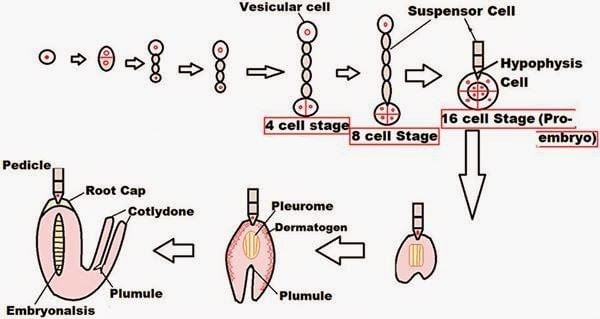 Stages of Embryo Development in Capsella Bursa-Pastoris (Dicot)
Stages of Embryo Development in Capsella Bursa-Pastoris (Dicot)
- The development of embryos in Capsella is first time discovered by "Hanstein".
- Question for Post-Fertilisation Structures and EventsTry yourself:During the development of the dicot embryo in Capsella, which cells are formed towards the chalaza?View Solution
➢Development of Embryo in Monocotyledon
- The Lilium type of embryonic development is found in monocotyledons. The first division is the transverse division in Oospore.
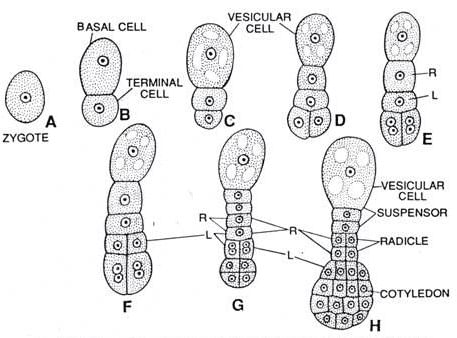 Stages in the Development of a Typical Monocot Embryo in Sagittaria
Stages in the Development of a Typical Monocot Embryo in Sagittaria - Results two cells are formed, the upper cell chalazal is called the embryonal cell and the lower micropylar cell is termed as the basal cell.
- The basal cell does not divide further and later on it increases in size and form a single-celled vesicular suspensor. The only embryonal cell divides transversely in which terminal cell is called a cotyledon cell and the lower (middle) cell is known as embryonal axis cell.
- A transverse division takes place in the embryonal axis cell to gives rise to two cells.
The one cell out of two gives rise to plumule initial and another gives rise to radicle initial. - The plumule initially divides to form a plumule of the embryo.
- Radicle initial divides to form radicle. In this, both the initials are responsible to form an embryo in a Lateral position.
- In Angiosperms, the development of the embryo is meroblastic and endoscopic (towards the chalaza).
- In the grass family, the cotyledon is called the scutellum that is situated towards one side (lateral) of the embryonal axis. At its lower end, the embryonal axis has the radical and root cap enclosed in an undifferentiated sheath called coleorhiza.
- The portion of the embryonal axis above the level of attachment of the scutellum is the epicotyl. Epicotyl has a shoot apex and a few leaf primordia enclosed in a hollow foliar structure, the coleoptile.
- The Lilium type of embryonic development is found in monocotyledons. The first division is the transverse division in Oospore.
➢Reproduction in Plant
Development of Floral Organs in Arabidopsis
- Arabidopsis thaliana is a small weed belonging to the family Brassicaceae.
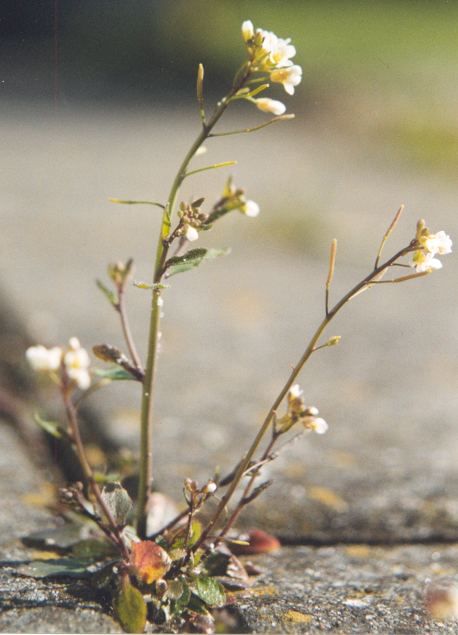 Arabidopsis thaliana
Arabidopsis thaliana - It contains approximately 26000 genes and the complete gene sequence has been studies by plant biologists.
- Like other plants in Arabidopsis, the initiation of flowering is influenced by various environmental factors. Of these photoperiodism and temperature are more important. Under the influence of the two factors, the apical meristem starts producing flowers instead of vegetative structure. The development of calyx, corolla, androecium and gynoecium is controlled by specific genes. These are called homeotic selector genes.
Example: Apetala-2, Apetala-3, Agamous etc. - As a result of the effect of these genes, the development of leaves is replaced by the development of flowers.
- Similar to leaves, the floral organs developed by periclinal divisions in protoderm or sub-protoderm cells. Initially, these cells show periclinal divisions followed by periclinal as well as anticlinal divisions resulting in the formation of an outgrowth. Cells of the outgrowth divide, develop and differentiate to form different floral organs.
- In Arabidopsis calyx are the first to develop followed by corolla, androecium and gynoecium. The order of development of floral may vary from plant to plant.
For example, in members of the family Umbelliferae, the sequence of development of floral organs is - androecium, corolla, calyx and gynoecium.
- Arabidopsis thaliana is a small weed belonging to the family Brassicaceae.
- Question for Post-Fertilisation Structures and EventsTry yourself:What environmental factors influence the initiation of flowering in Arabidopsis?View Solution
Table: Difference between Embryo and Endosperm
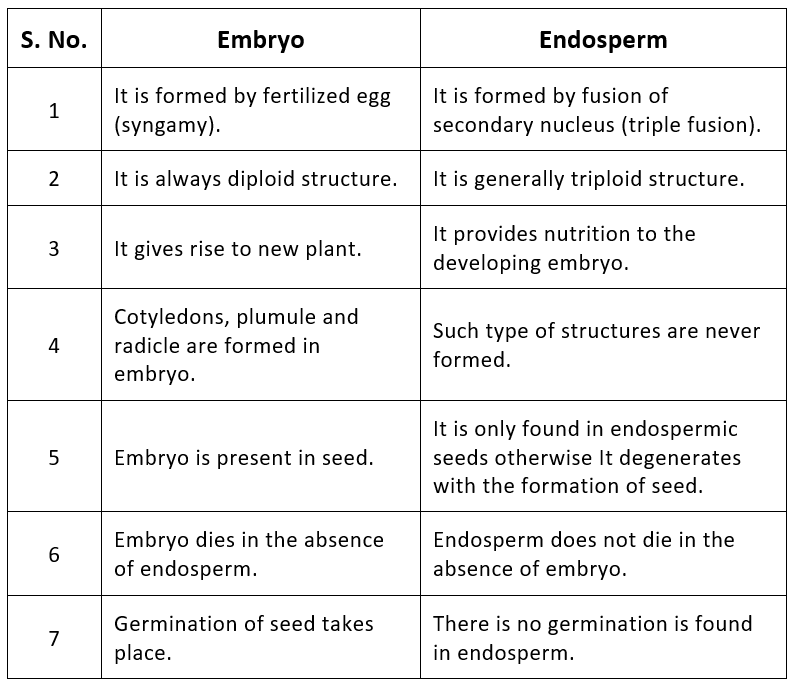
Table: Difference between Egg Cell and Secondary Nucleus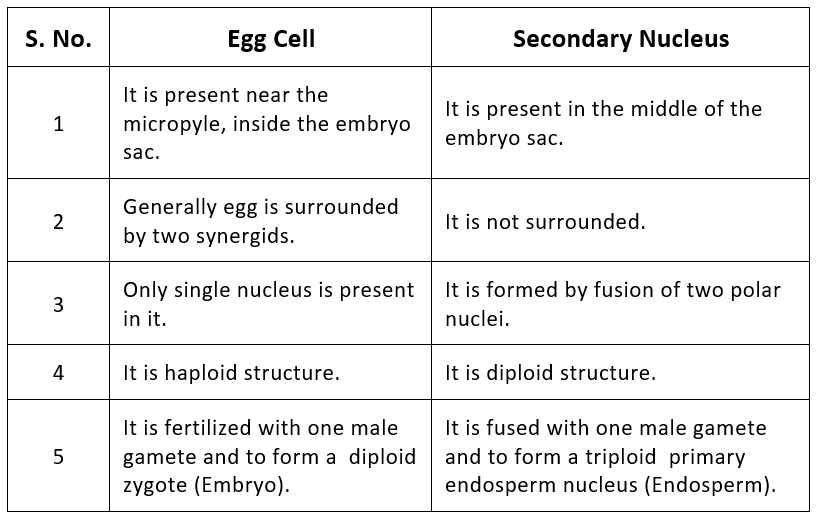
Table: Number of Chromosomes in Different Parts of Plant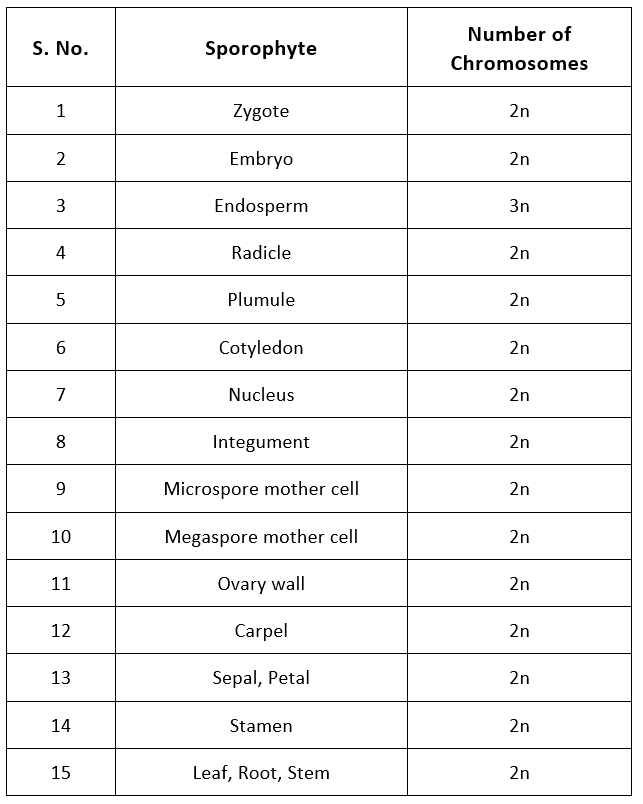
Table: Gametophyte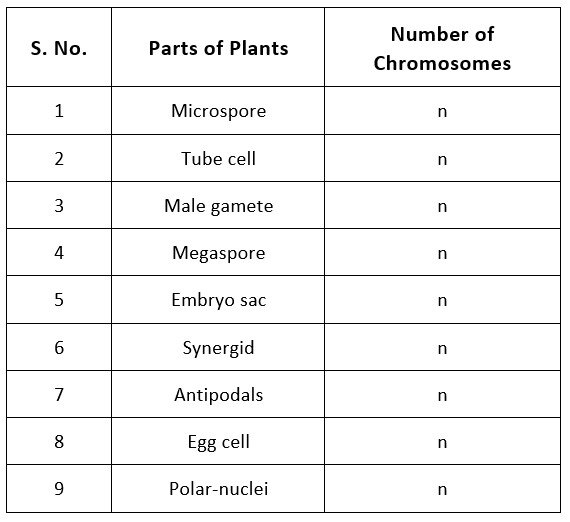
|
59 videos|290 docs|168 tests
|
FAQs on Post-Fertilisation Structures and Events - Biology Class 12 - NEET
| 1. What is the significance of the development of endosperm in post-fertilisation events? |  |
| 2. How does the development of the embryo occur in post-fertilisation events? |  |
| 3. What is the difference between monocotyledonous and dicotyledonous seeds in post-fertilisation events? |  |
| 4. How does the development of fruit play a role in post-fertilisation events? |  |
| 5. What is the significance of apomixis and polyembryony in post-fertilisation events? |  |

















